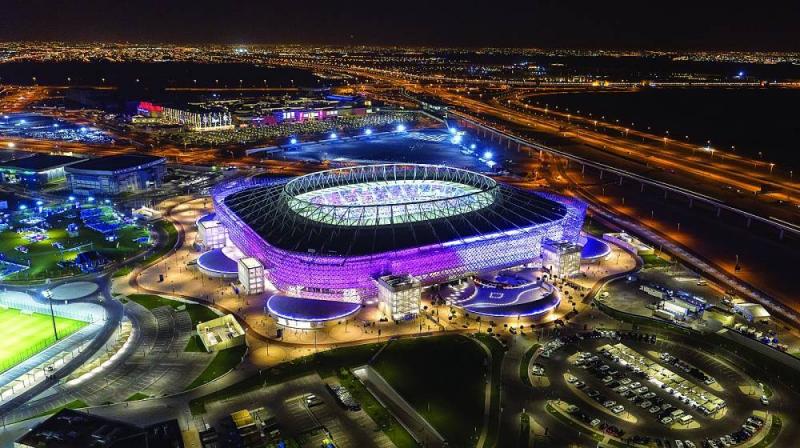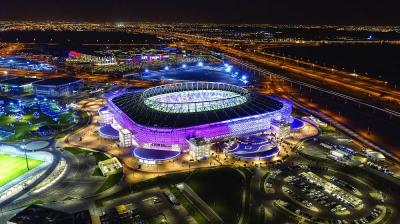Today marks the countdown to the last 500 days before the kickoff of the FIFA World Cup 2022, which will be hosted by Qatar for the first time in the Arab world and the Middle East, from November 21 to December 18 of next year. Since Qatar won the right to host the World Cup in 2010, it immediately began a race against time to fulfill its hosting commitments and achieve its promises of organizing an exceptional World Cup edition.
Today, Qatar has successfully completed 95 percent of the necessary infrastructure projects for the tournament, including stadiums and training facilities. Four stadiums have been announced as ready, and the Doha Metro lines have been operational for over two years, while work continues diligently on completing the highway network across the country. In light of ongoing preparations to welcome more than a million fans during the hosting period, Qatar spares no effort to ensure that fans, players, and officials have a unique experience that reflects Arab culture and its authentic traditions.
The FIFA World Cup Qatar 2022 will take place in eight World Cup stadiums: Khalifa International, Al Janoub, Education City, Ahmad Bin Ali, and Al Bayt, which have been completed and are ready for the competitions, in addition to Al Thumama, Ras Abu Aboud, and Lusail, which will be unveiled before the end of this year. Most of the World Cup stadiums have been designed with architectural creativity that reflects Qatari and Arab culture, embodying some of its aspects and features. For example, the design of Al Bayt Stadium resembles a traditional Bedouin tent, while Lusail Stadium's shiny golden facade recalls the artistic pieces and gold utensils used by Arabs in ancient times. The rippling roof of Al Janoub Stadium represents the waves of the sea and the sails of boats that the people of Al Wakrah used to seek livelihood in the depths of the Arabian Gulf. Al Thumama Stadium has been designed by Qatari hands in the shape of the "ghutrah," a traditional head scarf worn by most men in the Arab region.
Additionally, the design of the stadiums considers the legacy to ensure that these sports facilities serve the community and its individuals after the conclusion of the World Cup. In this regard, there are plans to convert most stadiums into community, sports, and medical facilities after the tournament, along with donating some stadium seats to countries lacking sports infrastructure. Legacy initiatives will ensure that the World Cup in Qatar leaves a positive impact that benefits both Qatar and the world.
Furthermore, Qatar takes pride in constructing Ras Abu Aboud Stadium, which is the first stadium in the history of the World Cup that is fully dismantlable. This sports edifice is built using shipping containers and modular units, which will be completely dismantled after the tournament, allowing for re-use of its parts.
Given Qatar's geographical space, fans, players, and officials can expect an unparalleled experience during the 2022 World Cup, as everyone will find themselves at the heart of the event throughout the tournament. Visitors will arrive in Qatar through a single air gateway, Hamad International Airport, with the possibility of staying in one accommodation throughout the competition. Everyone will always be close to the match stadiums and all the country's tourist attractions. All eight stadiums are no more than 50 km from downtown Doha, which means short transit times via the Doha Metro or modern highway network.
The proximity of distances offers a golden opportunity for participating teams to train at a single venue throughout the tournament, allowing them to optimize their time and efforts for proper match preparation without the hassle of traveling from one city to another during the tournament. Fans will have the chance to attend two or more matches in a single day during the early stages of the competition, for the first time in modern World Cup history, as the longest distance between the stadiums is only 75 km (between Al Bayt Stadium and Al Janoub Stadium), while the shortest distance between stadiums is 5 km (between Ahmad Bin Ali Stadium and Education City Stadium). Five World Cup stadiums are directly connected to the metro network, while the other three are in proximity to metro stations accessible via buses.
The State of Qatar is working to leverage all available facilities to meet its sustainability commitments and ensure that the tournament does not leave behind any unused accommodations. Fans and visitors will have multiple housing options that meet their aspirations and fit their budgets, including hotel rooms ranging from two to five stars, residential apartments, fan villages, and rooms aboard floating hotels on cruise ships docked at the Doha port overlooking the Arabian Gulf. Among the innovative accommodation options available for World Cup fans will be stays in desert camps, allowing guests to experience authentic Qatari hospitality and traditions.
Fan delegations will arrive in Qatar via Hamad International Airport. Thanks to public transport, especially the metro, fans will easily move to and from the tournament stadiums and across the country. The Doha Metro network features three lines and 37 stations, connecting to five of the eight World Cup stadiums, with a ticket price for a single trip set at two Qatari riyals (0.55 US dollars). The Doha Metro has been designed with accessibility standards in mind to accommodate fans and visitors with disabilities.
The FIFA World Cup matches in Qatar will take place in November and December. The weather at that time will be perfect for players and visitors, with average temperatures in Qatar ranging from 18 to 24 degrees Celsius, allowing visitors to enjoy the warmth of the sun on Qatar's beaches and the breezes in the desert. Qatar boasts a range of unique museums, shops, and global shopping centers. Additionally, visitors can engage in unique experiences such as driving over hills and sand dunes, enjoying various water sports, or playing golf at the Education City Golf Club or tennis at the Khalifa International Tennis and Squash Complex.




